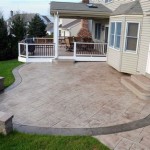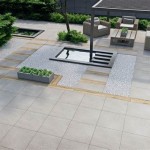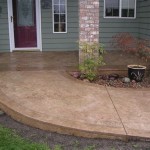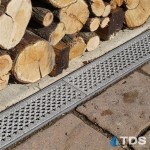How To Refresh an Old Concrete Patio
A concrete patio represents a valuable outdoor living space that can significantly enhance property value and provide a comfortable area for relaxation and entertainment. However, over time, exposure to the elements, foot traffic, and general wear and tear can lead to cosmetic imperfections, such as staining, cracking, and discoloration. Refreshed patios restore the structural integrity and improve the aesthetic appeal of the patio. This article provides a comprehensive guide to refreshing an old concrete patio, covering essential steps from assessment to sealing.
Assessing the Condition of the Concrete Patio
The initial step in refreshing an old concrete patio involves a thorough assessment of its current condition. This assessment serves to identify the specific problems requiring attention and helps determine the most appropriate course of action. The following aspects require careful examination:
Cracks: Cracks represent one of the most common issues found in old concrete patios. Cracks compromise the structural integrity of the patio and allow water to penetrate, potentially leading to further damage from freeze-thaw cycles. Document the size, depth, and pattern of all cracks. Fine hairline cracks are generally considered less serious than wider, deeper cracks that indicate a more significant structural problem. Pay close attention to cracks that appear near the edges of the patio or around any supports. The presence of vegetation growing within cracks often indicates moisture retention, exacerbating the damage.
Stains: Concrete is a porous material, making it susceptible to staining from various sources, including oil, grease, rust, mildew, and organic matter like leaves. Identifying the type of stain is crucial for selecting the appropriate cleaning agents. Oil and grease stains typically appear as dark, greasy patches, while rust stains often present as reddish-brown discolorations. Mildew stains manifest as black or green spots, particularly in shaded or damp areas. Organic stains from leaves and debris can leave brownish or yellowish residue. Determine the extent and severity of the staining, noting any areas where stains are deeply embedded.
Spalling and Scaling: Spalling and scaling refer to the deterioration of the concrete surface, resulting in flaking, chipping, or pitting. Spalling typically involves larger, deeper pieces of concrete breaking away, while scaling involves the surface layer peeling off. These issues are often caused by freeze-thaw cycles, where water penetrates the concrete, expands when frozen, and exerts pressure that leads to cracking and disintegration. The presence of de-icing salts can accelerate this process. Carefully examine the surface for any signs of loose or crumbling concrete, paying particular attention to areas exposed to significant moisture or temperature fluctuations. The depth and extent of the spalling or scaling will determine the necessary repair measures.
Discoloration: Over time, concrete patios can develop an uneven or faded appearance due to prolonged exposure to sunlight and the elements. Discoloration can also occur due to the leaching of minerals from the concrete or the accumulation of dirt and grime embedded in the surface. Examine the patio for any areas where the color is significantly different from the original concrete. Note any patterns of discoloration, as they might indicate specific causes, such as water runoff or chemical exposure. The severity of the discoloration will determine whether a simple cleaning or a more extensive resurfacing is required.
Settling and Unevenness: Uneven settling of the concrete can create tripping hazards and affect the patio's overall stability. Settling occurs when the soil beneath the patio shifts or compacts, causing the concrete slabs to sink or tilt. Inspect the patio for any noticeable differences in elevation between the slabs. Use a level to check for areas where the surface is significantly sloped or uneven. Identify any potential causes of settling, such as poor drainage or unstable soil conditions.
Cleaning the Concrete Patio
Once the assessment is complete, the next step involves thoroughly cleaning the concrete patio. A clean surface is essential for effective repairs and sealing. The cleaning process typically involves the following steps:
Removing Debris: Begin by removing all loose debris from the patio, including leaves, twigs, dirt, and any other accumulated materials. Sweep the entire surface with a stiff-bristled broom to clear away any loose particles. Remove potted plants, furniture, and other items from the patio to provide unobstructed access to the entire surface.
Pressure Washing: Pressure washing is an effective way to remove stubborn dirt, grime, and loose debris from the concrete surface. Use a pressure washer with a fan nozzle to avoid damaging the concrete. Start with a low pressure setting and gradually increase it as needed to remove the dirt. Hold the nozzle at a consistent distance from the surface and move it in overlapping strokes to ensure even cleaning. Pay particular attention to areas with heavy staining or mildew growth. Rinse the surface thoroughly with clean water after pressure washing to remove any remaining residue.
Addressing Stains: Different types of stains require specific cleaning agents. For oil and grease stains, use a degreasing cleaner specifically designed for concrete. Apply the cleaner according to the manufacturer's instructions and scrub the stained area with a stiff brush. Rinse thoroughly with water. For rust stains, use a rust remover formulated for concrete. Apply the remover, let it sit for the recommended time, and then scrub and rinse. For mildew stains, use a solution of bleach and water (1 part bleach to 3 parts water). Apply the solution, let it sit for a few minutes, and then scrub and rinse. Always wear gloves and eye protection when working with cleaning chemicals. It's recommended to test any cleaning solution on a small, inconspicuous area first to ensure it does not damage or discolor the concrete.
Scrubbing Difficult Areas: For areas where pressure washing alone is not sufficient, manual scrubbing with a stiff brush and a suitable cleaning solution is necessary. Use a concrete cleaner or a mixture of detergent and water. Apply the cleaner to the area and scrub vigorously with the brush. Rinse thoroughly with clean water to remove any remaining cleaner and debris. For particularly stubborn stains, consider using a specialized concrete scrub brush with abrasive bristles.
Repairing Cracks and Damage
After cleaning the patio, any cracks or damage require repair. Addressing these issues prevents further deterioration and restores the structural integrity of the patio. The following steps outline the repair process:
Preparing the Cracks: Before filling cracks, it is essential to prepare them properly. Use a hammer and chisel or a concrete crack chaser to widen and deepen the cracks slightly. This creates a larger surface area for the patching material to adhere to. Remove any loose debris or crumbling concrete from the cracks using a wire brush or a shop vacuum. Clean the cracks thoroughly with water and allow them to dry completely before proceeding.
Filling Cracks: For narrow hairline cracks, use a concrete crack filler or sealant specifically designed for this purpose. Apply the filler using a caulking gun, ensuring that it completely fills the crack. Smooth the surface of the filler with a putty knife or trowel to create a flush finish. For wider cracks, use a concrete patching compound. Mix the compound according to the manufacturer's instructions and apply it to the cracks using a trowel. Pack the compound tightly into the cracks and smooth the surface to match the surrounding concrete. Allow the patching compound to cure completely according to the manufacturer's instructions before proceeding to the next step.
Repairing Spalling and Scaling: For areas with minor spalling or scaling, use a concrete patching compound to repair the damage. Clean the affected area thoroughly and remove any loose or crumbling concrete. Apply the patching compound to the area, filling in any voids or depressions. Smooth the surface of the compound to match the surrounding concrete. For more extensive spalling or scaling, it may be necessary to apply a concrete resurfacer. This involves applying a thin layer of concrete over the entire surface of the patio to create a new, uniform surface. Follow the manufacturer's instructions for mixing and applying the resurfacer. Use a trowel or squeegee to spread the resurfacer evenly over the surface. Allow the resurfacer to cure completely before proceeding.
Addressing Settling: Repairing settled concrete patios can be intricate and may require professional assistance. For minor settling, the process of mudjacking may be consider. Mudjacking involves injecting a slurry of water, cement, and soil beneath the settled slab to lift it back into place. For significant settling, slab replacement may be better. This involves removing the affected concrete slab and pouring a new one in its place. Ensure that the underlying soil is properly compacted and graded before pouring the new slab to prevent future settling.
Sealing the Concrete Patio
The final step in refreshing an old concrete patio is sealing the surface. Sealing protects the concrete from moisture penetration, stains, and damage from freeze-thaw cycles. It also enhances the appearance of the patio and makes it easier to clean. The following steps outline the sealing process:
Choosing a Sealer: Several types of concrete sealers are available, each with its own advantages and disadvantages. Penetrating sealers penetrate the concrete and create a water-repellent barrier without changing the appearance of the surface. These sealers are ideal for patios with a natural concrete look. Acrylic sealers provide a glossy finish and enhance the color of the concrete. They are more susceptible to scratches and wear than penetrating sealers. Epoxy sealers offer superior protection against stains and chemicals. They are typically used in high-traffic areas or where chemical resistance is important. Choose a sealer based on the desired appearance, level of protection, and budget.
Preparing the Surface: Before applying the sealer, ensure that the concrete surface is clean, dry, and free from any debris or contaminants. Pressure wash the surface to remove any remaining dirt or grime. Allow the surface to dry completely before proceeding. Check the manufacturer's instructions for specific surface preparation recommendations.
Applying the Sealer: Apply the sealer according to the manufacturer's instructions. Use a roller, brush, or sprayer to apply a thin, even coat of sealer to the surface. Avoid applying too much sealer, as this can result in a sticky or cloudy finish. Allow the sealer to dry completely before applying a second coat, if recommended. Pay attention to the drying time specified by the manufacturer. Avoid walking on the sealed surface until it is fully cured. Protect the sealed surface from rain or moisture during the curing process.
Maintaining the Seal: To prolong the life of the sealer, clean the concrete patio regularly with a mild detergent and water. Avoid using harsh chemicals or abrasive cleaners, as these can damage the sealer. Reapply the sealer every 1-3 years, depending on the type of sealer and the level of traffic. Inspect the sealed surface regularly for any signs of wear or damage and make repairs as needed.

Resurfacing A Concrete Patio For Budget Diy Makeover Fab Everyday

Diy Concrete Patio Makeover The Frugal South

3 Concrete Resurfacing Options For Patio

Resurfacing A Concrete Patio For Budget Diy Makeover Fab Everyday

Ed Concrete See How We Repaired Our Gross Patio 2024

Diy Concrete Patio Upgrade Ideas The Garden Glove

9 Great Concrete Patio Ideas For A Makeover Remodelaholic

Acid Stain Concrete Patio Direct Colors

Pin On Backyard

Diy Broken Concrete Patio Urbanite Full Tutorial An Oregon Cottage
Related Posts








